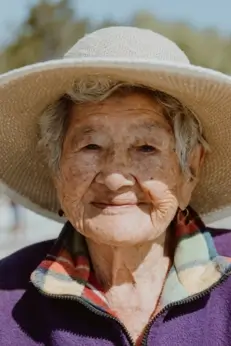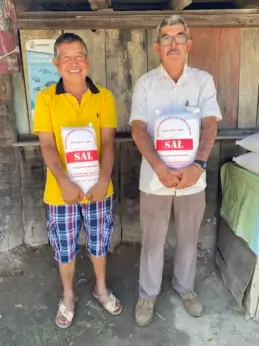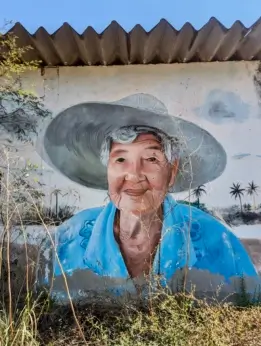She taught her family the traditional ways of harvesting salt, and today, they still harvest completely by hand. An eco-tourism model helps this family keep going.

Quintina Ayvar de la Cruz is the living embodiment of the environment that has been her home for 97 years. She has a brightness that matches the green mangroves near her house in Juluchuca, Mexico and she sparkles like the salt that has been the focus of her life’s work—and a great source of her life’s joy, too.
“I started from a young age, when I was about six years old,” says Ayvar de la Cruz, recalling her earliest experiences of harvesting salt from the area known in the vicinity as Las Salinas. “I began with my parents, then continued with my brothers, then with my children from when they were eight.”

Quintina Ayvar de la Cruz. Photography by Leia Marasovich.
The work of harvesting usually begins in February or March and carries on for three or four months, depending on the weather. The members of the Ayvar de la Cruz family are the only remaining residents of the region to continue harvesting salt in the traditional way, which is done completely by hand with the help of tools made only from local, natural materials, rather than relying on modern equipment. It begins by mixing a rustic concrete from sand and clay to form shallow square basins at the edge of the lagoon. Those lagoons are then filled with both freshwater and saltwater, before lime (in its mineral powder form) is added to the small pools to help separate out the salt from the water. A special rake called a tarecua facilitates this process. There, the mixture dries in the sun over the next five or so days and the salt is collected once the water has evaporated.
“We start at six in the morning,” says Ayvar de la Cruz. “We start early because when it’s cool, you can move forward without getting so tired. At midday, the heat becomes very strong.” A break is taken from around 11:00 AM to 4:00 PM. When the sun is less intense, the work continues until all the light is gone, around eight in the evening.
The days are long and the work is hard, but Ayvar de la Cruz focuses on the experience of being in this extraordinary environment. “You feel the fresh air and cool water of the mangroves. It is a feeling of freedom and tranquility.”

The salt pools where Quintina Ayvar de la Cruz harvests. Photography by Leia Marasovich.
At a distance of 90 years or so, she can still describe with impressive clarity the sensations of that first encounter with the salt flats—the feeling of being carried in her father’s arms and on the back of a donkey as they made the journey there and, later, to the closest town, Petatlán, to sell the salt, as well as its dazzling whiteness when arranged into a mound across mats made of palm fronds after harvesting.
Over the last decade, all other salt producers in the area have modernized the process. One of the most significant changes has been the implementation of plastic sheets as the base for the drying areas, which makes production go more quickly.
“Salt made using plastic can be sold for much cheaper and it hurts our local market,” says Ayvar de la Cruz’s son, Don Alejandro. “We don’t market our salt as artisanal, but everyone knows around here that we’re the only ones doing it the natural way.”

Don Alejandro (left) holds the salt his family produces. Photography by Elena Valeriote.
Ayvar de la Cruz laments that the salt flats are now permeated with a “plastic smell” and her son notes that workers often leave their equipment in the lagoon out of season and, when hurricanes hit the coast, plastic pieces can end up elsewhere, endangering local wildlife. The surrounding mangroves are a key habitat for a diverse array of plants and animals, including shrimp, fish, crabs, pink herons, deer and coati (a kind of badger), as well as a type of tree known colloquially as salado (“salty”) because it survives in saltwater.
In 2006, the Ayvar de la Cruz family was contacted by a new hospitality business called Playa Viva. Its owner, David Leventhal, was planning to construct a resort nearby founded on the principles of regenerative tourism, and he was interested in learning about the local ecosystems and community. Playa Viva hoped that collaborating with residents such as Ayvar de la Cruz could help create a space that would allow visitors to experience the beauty of this stretch of the Mexican coast, while also having a positive social and environmental impact that would linger longer than they would.
In 2013, Playa Viva instituted the Regenerative Trust, with environmental and social goals that range from restoring ecosystems to raising endangered species for release and donating school supplies to children. Two percent of all earnings from guest reservations are channeled into these local programs.

Salt for sale. Photography by Elena Valeriote.
One of the primary programs funded by the Regenerative Trust is as ReSiMar—short for “Regenerating from Sierra to Mar”—which refers to its area of focus, between the Sierra Madre Mountain Range and the Pacific Ocean. Through ReSiMar, Playa Viva aims to regenerate the entire ecosystem of this watershed. Sourcing ingredients from sustainable fisheries and other small businesses that depend on the watershed, like that of the Ayvar de la Cruz family, is part of this effort.
Playa Viva committed to buying the salt for its restaurant exclusively from the Ayvar de la Cruz family and, when it started welcoming guests to Juluchuca a few years later, it also offered tours of Las Salinas together during the salt harvest season. This relationship with Playa Viva has been a vital source of support in the family’s efforts to carry on harvesting salt as their ancestors did and it has given them a chance to share their work with foreigners for the first time.

A mural of Ayvar de la Cruz in her hometown. Photography by Elena Valeriote.
ReSiMar also records vital information about the watershed to understand the scope of their impact and determine which aspects need the most attention. In 2023, the ReSiMar team tracked water quality, focusing on pollution in the form of plastic packaging and glass bottles. From there, they identified a need for improved ecological education and recycling programs, so they focused on bringing students to the watershed and establishing a town community center. “Water studies provide essential baseline data on the quality and quantity of water during both the rainy and dry seasons,” says Levanthal. “We then compare this data year after year to observe changes.”
With nearly a century of memories to draw on from living in this part of the Guerrero region along the Pacific coast, Ayvar de la Cruz also holds within her the history of this place. She knows the plants and animals that are at home in this unique tropical ecosystem, the natural rhythms of the seasons and how to work with them to harvest salt in a way that the local community has practiced for hundreds, if not thousands, of years. For this reason, it is all the more striking that, in 2024, for the first time in Ayvar de la Cruz’s long life, unusual weather patterns caused a rupture in the timeline of this historic tradition.
“Every year, there is a rainy season and the lagoon fills. Then it empties and the salt flats are left dry, ready to be worked. It’s a natural cycle that always happens,” says Alejandro Ayvar, the youngest of Ayvar de la Cruz’s six sons. He and his brothers, along with their three sisters, have assisted their mother with the salt harvest on and off since their childhood. “This season, the lagoon did not empty adequately and the areas where salt is produced did not get dry enough.”

Ayvar de la Cruz and family. Photography by Leia Marasovich.
The unseasonably late rains that caused the local estuary system to overflow and Las Salinas to flood during the normal harvest time is just one example of the consequences of the climate crisis as they are being experienced in this part of the world.
“It’s not the same anymore,” Ayvar de la Cruz says of the local climate in recent years and how this affects the salt flats. “The temperature of the water has changed a lot and it takes more time to harvest the salt.”
As the climate changes and the younger generations of the Ayvar de la Cruz family find more financially stable prospects in other fields of work, the future of this tradition remains uncertain, but Ayvar de la Cruz’s legacy will not soon be forgotten. Her singular connection with this local environment and her commitment to this historic way of harvesting salt is commemorated in a mural on a building near Las Salinas, painted by a visiting artist about six years ago.
There is value, too, in simply having a conversation about salt, considering its place of origin and the people who harvested it. For as challenging as it can be to create systems that preserve our ancient food practices, it is easy to at least preserve the memory of them.
“Thank you for coming to make me happy,” Ayvar de la Cruz says at the end of the interview. “To remember is to live again.”
All interviews have been translated from Spanish into English with the assistance of Ximena Rodriguez, Juan Carlos “Johnny” Solis and David Leventhal.


